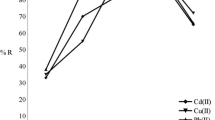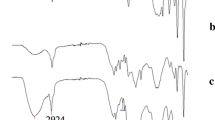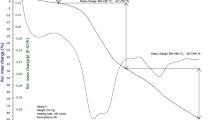Abstract
The present research describes the successful preparation of melon peel biochar modified with CoFe2O4 (MPBC/CoFe2O4) followed by its usage as a new sorbent to separate, preconcentrate, and determine the toxic heavy metal ions by magnetic solid-phase extraction. The metal ion desorption was performed by 0.1 M HCl solution with a volume of 5.0 mL. Flame atomic absorption spectrometry (FAAS) was utilized for detection of the analyte levels. SEM–EDX, TEM, XRD, and FTIR techniques were carried out to illuminate the structure of MPBC/CoFe2O4. The fundamental variables affecting the adsorption and elution efficiencies of the analyte ions including solution pH, MPBC/CoFe2O4 amount, type and concentration of eluent, adsorption and desorption equilibrium time, and sample volume were optimized. The detection limits were calculated as 0.41, 1.82, and 3.16 µg L−1 for Cu2+, Cd2+, and Pb2+ ions, respectively, with the relative standard deviation of lower than 4.2%. There were no substantial interference effects on the analyte ion recovery due to the presence of foreign ions at high levels. Five minutes of contact time was adequate to attain the adsorption equilibrium. The adsorption capacity of MPBC/CoFe2O4 was obtained as 106.4, 65.4, and 188.7 mg g−1 for Cu2+, Cd2+, and Pb2+ ions, respectively, by utilizing Langmuir isotherm model. The pseudo-second order model is favorable to identify the adsorption kinetics. The method was validated by spike/recovery test, and then, it was successfully implemented to determine the aforementioned analyte levels in sea and stream water, pepper, black cabbage, eggplant, and tomato samples.








Similar content being viewed by others
Availability of data and material
All data generated or analyzed during this study are included in this published article.
Code availability
Not applicable.
References
Ahmadi, M., Kouhgardi, E., & Ramavandi, B. (2016). Physico-chemical study of dew melon peel biochar for chromium attenuation from simulated and actual wastewaters. Korean Journal of Chemical Engineering, 33(9), 2589–2601.
Amin, M. T., Alazba, A. A., & Shafiq, M. (2019). Comparative study for adsorption of methylene blue dye on biochar derived from orange peel and banana biomass in aqueous solutions. Environmental Monitoring and Assessment, 191, 735.
Assi, N., Azar, P. A., Tehrani, M. S., Husain, S. W., Darwish, M., & Pourmand, S. (2019). Selective solid phase extraction using 1,5-diphenylcarbazide-modified magnetic nanoparticles for speciation of Cr(VI) and Cr(III) in aqueous solutions. International Journal of Environmental Science and Technology, 16, 4739–4748.
Behbahani, M., Salarian, M., Amini, M. M., Sadeghi, O., Bagheri, A., & Bagheri, S. (2013). Application of a new functionalized nanoporous silica for simultaneous trace separation and determination of Cd(II), Cu(II), Ni(II), and Pb(II) in food and agricultural products. Food Analytical Methods, 6, 1320–1329.
Bigdeli, M., & Seilsepour, M. (2008). Investigation of metals accumulation in some vegetables irrigated with waste water in Shahre Rey-Iran and toxicological implications. American-Eurasian Journal of Agricultural & Environmental Sciences, 4, 86–92.
Buema, G., Borhan, A. I., Herea, D. D., Stoian, G., Chiriac, H., Lupu, N., Roman, T., Pui, A., Harja, M., & Gherca, D. (2021). Magnetic solid-phase extraction of cadmium ions by hybrid self-assembled multicore type nanobeads. Polymers, 13, 229.
Dahaghin, Z., Mousavi, H. Z., & Sajjadi, S. M. (2017). Trace amounts of Cd(II), Cu(II) and Pb(II) ions monitoring using Fe3O4@graphene oxide nanocomposite modified via 2-mercaptobenzothiazole as a novel and efficient nanosorbent. Journal of Molecular Liquids, 231, 386–395.
Dubinin, M. M., & Radushkevich, L. V. (1947). Equation of the characteristic curve of activated charcoal. Proceedings of the Academy of Sciences of the USSR, Physical Chemistry Section, 55, 331–333.
Duran, A., Tuzen, M., & Soylak, M. (2009a). Preconcentration of some trace elements via using multiwalled carbon nanotubes as solid phase extraction adsorbent. Journal of Hazardous Materials, 169, 466–471.
Duran, C., Bulut, V. N., Gundogdu, A., Ozdes, D., Yildirim, N., Soylak, M., Senturk, H. B., & Elci, L. (2009b). Carrier element-free coprecipitation with 3-phenly-4-o-hydroxybenzylidenamino-4,5-dihydro-1,2,4-triazole-5-one for separation/preconcentration of Cr(III), Fe(III), Pb(II) and Zn(II) from aqueous solutions. Journal of Hazardous Materials, 167(1–3), 294–299.
Farajvand, M., Kiarostami, V., Davallo, M., & Ghaedi, A. (2019). Simultaneous extraction of Cu2+ and Cd2+ ions in water, wastewater, and food samples using solvent-terminated dispersive liquid–liquid microextraction: Optimization by multiobjective evolutionary algorithm based on decomposition. Environmental Monitoring and Assessment, 191, 287.
Foroutan, R., Mohammadi, R., Ramavandi, B., & Bastanian, M. (2018). Removal characteristics of chromium by activated carbon/ CoFe2O4 magnetic composite and Phoenix dactylifera stone carbon. Korean Journal of Chemical Engineering, 35(11), 2207–2219.
Freundlich, H. M. F. (1906). Uber die adsorption in lösungen. Zeitschrift Für Physikalische Chemie, 57, 385–470.
Ghorbani, Y. A., Ghoreishi, S. M., & Ghani, M. (2020). Derived N-doped carbon through core-shell structured metal-organic frameworks as a novel sorbent for dispersive solid phase extraction of Cr(III) and Pb(II) from water samples followed by quantitation through flame atomic absorption spectrometry, Microchemical Journal, 155, 104786.
Gouda, A. A. (2014). Solid-phase extraction using multiwalled carbon nanotubes and quinalizarin for preconcentration and determination of trace amounts of some heavy metals in food, water and environmental samples. International Journal of Environmental Analytical Chemistry, 94, 1210–1222.
Gundogdu, A., Duran, C., Senturk, H. B., Soylak, M., Ozdes, D., Serencam, H., & Imamoglu, M. (2012). Adsorption of phenol from aqueous solution on a low-cost activated carbon produced from tea ındustry waste: Equilibrium, kinetic, and thermodynamic study. Journal of Chemical Engineering Data, 57, 2733–2743.
Han, L., Nie, X., Wei, J., Gu, M., Wu, W., & Chen, M. (2021). Effects of feedstock biopolymer compositions on the physiochemical characteristics of dissolved black carbon from lignocellulose-based biochar. Science of the Total Environment, 751, 141491.
Heidari, M., Ghanemi, K., & Nikpour, Y. (2020). Applying Al2O3@Ag@trithiocyanuric acid as an efficient metal ion scavenger for the selective extraction of iron (III) and lead (II) from environmental waters. Ecotoxicology and Environmental Safety, 203, 110995.
Ho, Y. S., & McKay, G. (1998). Kinetic models for the sorption of dye from aqueous solution by wood. Journal of Environment Science Health. Part B: Process Safety and Environmental Protection, 76, 183–191.
Huang, L., Huang, W., Shen, R., & Shuai, Q. (2020). Chitosan/thiol functionalized metal–organic framework composite for the simultaneous determination of lead and cadmium ions in food samples. Food Chemistry, 330, 127212.
Kanani, N., Bayat, M., Shemirani, F., Ghasemi, J. B., Bahrami, Z., & Badiei, A. (2018). Synthesis of magnetically modified mesoporous nanoparticles and their application in simultaneous determination of Pb(II), Cd(II) and Cu(II). Research on Chemical Intermediates, 44, 1689–1709.
Khan, M., Yilmaz, E., Sevinc, B., Sahmetlioglu, E., Shah, J., Jan, M. R., & Soylak, M. (2016). Preparation and characterization of magnetic allylamine modified graphene oxide-poly(vinylacetate-co-divinylbenzene) nanocomposite for vortex assisted magnetic solid phase extraction of some metal ions. Talanta, 146, 130–137.
Lagergren, S. (1898). About the theory of so-called adsorption of soluble substance. Kung Sven. Veten. Hand., 24, 1–39.
Langmuir, I. (1918). The adsorption of gases on plane surfaces of glass, mica and platinum. Journal of the American Chemical Society, 40, 1361–1403.
Le, V. T., Tran, T. K. N., Tran, D. L., Le, H. S., Doan, V. D., Bui, Q. D., & Nguyen, H. T. (2019). One-pot synthesis of a novel magnetic activated carbon/clay composite for removal of heavy metals from aqueous solution. Journal of Dispersion Science and Technology, 40(12), 1761–1776.
Li, X., Wang, C., Zhang, J., Liu, J., Liu, B., & Chen, G. (2020). Preparation and application of magnetic biochar in water treatment: A critical review. Science of the Total Environment, 711, 134847.
Li, S., Wu, Y., Zheng, Y., Jing, T., Tian, J., Zheng, H., Wang, N., Nan, J., & Ma, J. (2021). Free-radical and surface electron transfer dominated bisphenol A degradation in system of ozone and peroxydisulfate co-activated by CoFe2O4-biochar. Applied Surface Science, 541, 147887.
Manoochehria, M., Asgharinezhad, A. A., & Shekari, N. (2015). Synthesis, characterisation and analytical application of Fe3O4@SiO2@polyaminoquinoline magnetic nanocomposite for the extraction and preconcentration of Cd(II) and Pb(II) in food samples. Food Additives & Contaminants: Part A, 32, 737–747.
Mashhadizadeh, M. H., Amoli-Diva, M., Shapouri, M. R., & Afruzi, H. (2014). Solid phase extraction of trace amounts of silver, cadmium, copper, mercury, and lead in various food samples based on ethylene glycol bis-mercaptoacetate modified 3-(trimethoxysilyl)-1-propanethiol coated Fe3O4 nanoparticles. Food Chemistry, 151, 300–305.
McKay, G., El-Guendi, M., & Nassar, M. (1987). Equilibrium studies during the removal of dyestuffs from aqueous solutions using bagasse pith. Water Research, 21, 1513–1520.
Mehrabi, F., Vafaei, A., Ghaedi, M., Ghaedi, A. M., Dil, E., & Asfaram, A. A. (2017). Ultrasound assisted extraction of Maxilon Red GRL dye from water samples using cobalt ferrite nanoparticles loaded on activated carbon as sorbent: Optimization and modeling. Ultrasonics Sonochemistry, 38, 672–680.
Mosai, A. K., Chimuka, L., Cukrowska, E. M., Kotze, I. A., & Tutu, H. (2020). Removal of platinum (IV) from aqueous solutions with yeast functionalized bentonite. Chemosphere, 239, 124768.
Ozdes, D., & Duran, C. (2014). Preparation of a new sorbent, cetyltrimethylammonium bromide (CTAB)- modified obsidian, for the separation and preconcentration of Pb(II) and Cd(II) ions in food and water samples. Atomic Spectroscopy, 35, 118–126.
Ozdes, D., Duran, C., Senturk, H. B., Avan, H., & Bicer, B. (2014). Kinetics, thermodynamics and equilibrium evaluation of adsorptive removal of methylene blue onto natural ıllitic clay mineral. Desalination and Water Treatment, 52, 208–218.
Rahimi, Z., Sarafraz, H., Alahyarizadeh, Gh., & Shirani, A. S. (2018). Hydrothermal synthesis of magnetic CoFe2O4 nanoparticles and CoFe2O4/MWCNTs nanocomposites for U and Pb removal from aqueous solutions. Journal of Radioanalytical and Nuclear Chemistry, 317, 431–442.
Rahnama, R., & Najafi, M. (2016). The use of rapidly synergistic cloud point extraction for the separation and preconcentration of trace amounts of Ni (II) ions from food and water samples coupling with flame atomic absorption spectrometry determination. Environmental Monitoring and Assessment, 188, 150.
Ramadan, R. (2019). Physical study of cobalt ferrite and its application in purification of water. Applied Physics A, 125, 825.
Reddy, D. H. K., & Lee, S.-M. (2014). Magnetic biochar composite: Facile synthesis, characterization, and application for heavy metal removal. Colloids and Surfaces a: Physicochemical and Engineering Aspects, 454, 96–103.
Soylak, M., Acar, D., Yilmaz, E., El-Khodary, S. A., Morsy, M., & Ibrahim, M. (2019). Magnetic graphene oxide as an efficient adsorbent for the separation and preconcentration of Cu(II), Pb(II), and Cd(II) from environmental samples. Journal of AOAC International, 100, 1544–1550.
Soylak, M., Narin, I., Divrikli, U., Saracoglu, S., Elci, L., & Dogan, M. (2004). Preconcentration-separation of heavy metal ions in environmental samples by membrane filtration-atomic absorption spectrometry combination. Analytical Letters, 37, 767–780.
Suleiman, J. S., Hu, B., Peng, H., & Huang, C. (2009). Separation/preconcentration of trace amounts of Cr, Cu and Pb in environmental samples by magnetic solid-phase extraction with Bismuthiol-II-immobilized magnetic nanoparticles and their determination by ICP-OES. Talanta, 77, 1579–1583.
Sun, J., Liang, Q., Han, Q., Zhang, X., & Ding, M. (2015). One-step synthesis of magnetic graphene oxide nanocomposite and its application in magnetic solid phase extraction of heavy metal ions from biological samples. Talanta, 132, 557–563.
Suo, L., Dong, X., Gao, X., Xu, J., Huang, Z., Ye, J., Lu, X., & Zhao, L. (2019). Silica-coated magnetic graphene oxide nanocomposite based magnetic solid phase extraction of trace amounts of heavy metals in water samples prior to determination by inductively coupled plasma mass spectrometry. Microchemical Journal, 149, 104039.
Thamilarasi, M. J. V., Anilkumar, P., Theivarasu, C., & Sureshkumar, M. V. (2018). Removal of vanadium from wastewater using surface-modified lignocellulosic material. Environmental Science and Pollution Research, 25, 26182–26191.
Tokay, F., & Bagdat, S. (2019). Solid phase extraction and preconcentration of some metal ions using Schiff base immobilised silica gel followed by ICP-OES. International Journal of Environmental Analytical Chemistry, 99, 1528–1539.
Tu, Y., Ju, S., & Wang, P. (2016). Flame atomic absorption spectrometric determination of copper, lead, and cadmium in Gastrodiae rhizoma samples after preconcentration using magnetic solid-phase extraction. Spectroscopy Letters, 49, 249–256.
Tufekci, M., Bulut, V. N., Elvan, H., Ozdes, D., Soylak, M., & Duran, C. (2013). Determination of Pb(II), Zn(II), Cd(II) and Co(II) ions by flame atomic absorption spectrometry in food and water samples after preconcentration by coprecipitation with Mo(VI)-diethyldithiocarbamate. Environmental Monitoring and Assessment, 185, 1107–1115.
Vellaichamy, S., & Palanivelu, K. (2011). Preconcentration and separation of copper, nickel and zinc in aqueous samples by flame atomic absorption spectrometry after column solid-phase extraction onto MWCNTs impregnated with D2EHPA-TOPO mixture. Journal of Hazardous Materials, 185, 1131–1139.
Weber, W. J., Jr., & Morriss, J. C. (1963). Kinetics of adsorption on carbon from solution. Journal of the Sanitary Engineering Division, American Society of Civil Engineers, 89, 31–60.
Xu, H., Wu, Y., Wang, J., Shang, X., & Jiang, X. (2013). Simultaneous preconcentration of cadmium and lead in water samples with silica gel and determination by flame atomic absorption spectrometry. Journal of Environmental Sciences, 25, S45–S49.
Yağci, Ö., Akkaya, E., & Bakirdere, S. (2020). Nano-sized magnetic Ni particles based dispersive solid-phase extraction of trace Cd before the determination by flame atomic absorption spectrometry with slotted quartz tube: A new, accurate, and sensitive quantification method. Environmental Monitoring and Assessment, 192, 583.
You, Y., Shi, Z., Li, Y., Zhao, Z., He, B., & Cheng, X. (2021). Magnetic cobalt ferrite biochar composite as peroxymonosulfate activator for removal of lomefloxacin hydrochloride. Separation and Purification Technology, 272, 118889.
Zhang, S., Ji, Y., Dang, J., Zhao, J., & Chen, S. (2019). Magnetic apple pomace biochar: Simple preparation, characterization, and application for enriching Ag(I) in effluents. Science of the Total Environment, 668, 115–123.
Zhao, D., Li, J., Li, C., Juhasz, A. L., Scheckel, K. G., Luo, J., Li, H.-B., & Ma, L. Q. (2016). Lead relative bioavailability in lip products and their potential health risk to women. Environmental Science and Technology, 50(11), 6036–6043.
Zhao, J., Liang, G., Zhang, X., Cai, X., Li, R., Xie, X., & Wang, Z. (2019). Coating magnetic biochar with humic acid for high efficient removal of fluoroquinolone antibiotics in water. Science of the Total Environment, 688, 1205–1215.
Zhou, L., Ji, L., Ma, P.-C., Shao, Y., Zhang, H., Gao, W., & Li, Y. (2014). Development of carbon nanotubes/CoFe2O4 magnetic hybrid material for removal of tetrabromobisphenol A and Pb(II). Journal of Hazardous Materials, 265, 104–114.
Zhu, X., Cui, Y., Chang, X., & Wang, H. (2016). Selective solid-phase extraction and analysis of trace-level Cr(III), Fe(III), Pb(II), and Mn(II) ions in waste water using diethylenetriamine-functionalized carbon nanotubes dispersed in graphene oxide colloids. Talanta, 146, 358–363.
Funding
The financial support was received from the Unit of the Scientific Research Projects of Karadeniz Technical University.
Author information
Authors and Affiliations
Corresponding author
Ethics declarations
Ethics approval
Not applicable.
Consent to participate
Not applicable.
Consent for publication
Not applicable.
Competing interests
The authors declare no competing interests.
Additional information
Publisher's Note
Springer Nature remains neutral with regard to jurisdictional claims in published maps and institutional affiliations.
Rights and permissions
About this article
Cite this article
Ozdes, D., Duran, C. Preparation of melon peel biochar/CoFe2O4 as a new adsorbent for the separation and preconcentration of Cu(II), Cd(II), and Pb(II) ions by solid-phase extraction in water and vegetable samples. Environ Monit Assess 193, 642 (2021). https://doi.org/10.1007/s10661-021-09389-0
Received:
Accepted:
Published:
DOI: https://doi.org/10.1007/s10661-021-09389-0




